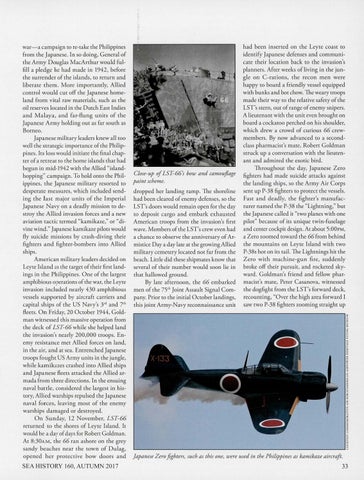war-a campaign to re-take the Philippines from the Japanese. In so doing, General of the Army Douglas MacArthur would fulfill a pledge he had made in 1942, before the surrender of the islands, to return and liberate them. More importantly, Allied control would cut off the Japanese homeland from vital raw materials, such as the oil reserves located in the Dutch East Indies and Malaya, and far-flung units of the Japanese Army holding out as far south as Borneo. Japanese military leaders knew all too well the strategic importance of the Philippines. Its loss would initiate the final chapter of a retreat to the home islands that had begun in mid-1942 with theAllied "islandhopping" campaign. To hold onto the Philippines, the Japanese military resorted to desperate measures, which included sending the last major units of the Imperial Japanese Navy on a deadly mission to destroy the Allied invasion forces and a new aviation tactic termed "kamikaze," or "divine wind." Japanese kamikaze pilots would fly suicide missions by crash-diving their fighters and fighter-bombers into Allied ships. American military leaders decided on Leyte Island as the target of their first landings in the Philippines. One of the largest amphibious operations of the war, the Leyte invasion included nearly 430 amphibious vessels supported by aircraft carriers and capital ships of the US Navy's 3rd and 7rh fleets . On Friday, 20 October 1944, Goldman witnessed this massive operation from the deck of LST-66 while she helped land the invasion's nearly 200,000 troops. Enemy resistance met Allied forces on land, in the air, and at sea. Entrenched Japanese troops fought US Army units in the jungle, while kamikazes crashed into Allied ships and Japanese fleets attacked the Allied armada from three directions. In the ensuing naval battle, considered the largest in history, Allied warships repulsed the Japanese naval forces, leaving most of the enemy warships damaged or destroyed. On Sunday, 12 November, LST-66 returned to the shores of Leyte Island. It would be a d ay of days for Robert Goldman. At 8:30AM, the 66 ran ashore on the grey sandy beaches near the town of Dulag, opened her protective bow doors and SEA HISTORY 160, AUTUMN 2017
Close-up of LST-665 bow and camouflage paint scheme. dropped her landing ramp. The shoreline had been cleared of enemy defenses, so the LST's doors would remain open for the day to deposit cargo and embark exhausted American troops from the invasion's first wave. Members of the LST's crew even had a chance to observe the anniversary of Armistice Day a day late at the growing Allied military cemetery located not far from the beach. Little did these shipmates know rhar several of their number would soon lie in that hallowed ground. By !are afternoon, the 66 embarked men of the 75'h Joint Assault Signal Company. Prior to the initial October landings, this joint Army-Navy reconnaissance unit
had been inserted on the Leyte coast to identify Japanese defenses and communicate their location back to the invasion's planners. After weeks ofliving in the jungle on C-rations, the recon men were happy to board a friendly vessel equipped with bunks and hot chow. The weary troops made their way to the relative safety of the LST's stern, our of range of enemy snipers. A lieutenant with the unit even brought on board a cockatoo perched on his shoulder, which drew a crowd of curious 66 crewmembers. By now advanced to a secondclass pharmacist's mate, Robert Goldman struck up a conversation wirh the lieutenant and admired the exotic bird. Throughout the day, Japanese Zero fighters had made suicide attacks against the landing ships, so the Army Air Corps sent up P-38 fighters to protect the vessels. Fast and deadly, the fighter's manufacturer named the P-38 the "Lightning," bur the Japanese called it "two planes with one pilot" because of its unique twin-fuselage and center cockpit design. At about 5:00PM, a Zero zoomed toward the 66 from behind the mountains on Leyte Island with two P-38s hot on its tail. The Lightnings hit the Zero with m achine-gun fire , suddenly broke off their pursuit, and rocketed skyward. Goldman's friend and fellow pharmacist's mate, Peter Casanova, witnessed the dogfight from the LST's forward deck, recounting, "Over the high area forward I saw two P-38 fighters zooming straight up
Japanese Zero fighters, such as this one, were used in the Philippines as kamikaze aircraft. 33
